Posts Tagged ‘veterinarians’
Should Your Dog Get a Choker Collar? Here’s What You Need to Know
 Whether or not your dog should wear a chain choker collar is a matter of debate among dog trainers, veterinarians, and animal welfare organizations. There are several factors to consider before deciding to use a chain choker collar:
Whether or not your dog should wear a chain choker collar is a matter of debate among dog trainers, veterinarians, and animal welfare organizations. There are several factors to consider before deciding to use a chain choker collar:
1 Training Methodology: Chain choker collars are often used in training as a correction tool. However, they are associated with aversive training methods that rely on punishing undesirable behaviors through discomfort or pain. Many modern dog trainers advocate for positive reinforcement-based training methods, which focus on rewarding desired behaviors rather than punishing unwanted ones.
2 Breed and Size of the Dog: Smaller or more delicate dog breeds may be more vulnerable to injury when using chain choker collars. Breeds with thin necks, like Greyhounds, may be at a higher risk.
3 Health and Behavior Issues: Some dogs may have underlying health issues or behavioral problems that make the use of chain choker collars risky or inappropriate. For example, dogs with respiratory problems, brachycephalic breeds (i.e., Bulldogs), or fearful and aggressive should not be subjected to such collars.
4 Training Experience: If you are not experienced in using chain choker collars correctly, there is a risk of causing harm to your dog or reinforcing negative behaviors unintentionally. It is crucial to learn how to use these collars properly if you choose to use them.
5 Alternatives: There are many alternative training tools and methods available that can effectively train dogs without resorting to aversive methods. Positive reinforcement, clicker training, and head halters are examples of more humane and effective training tools.
6 Consultation with a Professional: If you are considering using a chain choker collar, it is strongly recommended that you consult with a professional dog trainer or behavioralist who can assess your dog’s specific needs and help you make an informed decision.
7 Local Laws and Regulations: Some places have laws and regulations that restrict or even ban the use of certain dog collars, including chain choker collars. Be sure to check your local laws and follow them accordingly.
If you have any questions about this or anything else, don’t hesitate to contact our office.
Dr. Olsen’s Breed Spotlight: The Tibetan Mastiff

Tibetan Mastiff
The Tibetan Mastiff is a large-size Tibetan dog breed. It has a medium to long double coat and is found in many colors. These can be solid black, black and tan, various shades of red (from pale gold to deep red), and bluish gray. Sometimes, they can have white markings around their neck, chest, and legs.
The term mastiff goes back to when the Europeans first went to Tibet. They used the term to refer to nearly all large dog breeds in the West. Early Western visitors misnamed several of its breeds through this process. For example, the Tibetan terrier is not a terrier, and the Tibetan spaniel is not a spaniel.
In the early 20th century, the Prince of Wales, George, introduced a pair of Tibetan Mastiffs to the United Kingdom, which caused the breed to become prevalent enough in England to be shown at the Crystal Palace show in 1906. Since 1980, the breed has been gaining in popularity worldwide.
The Tibetan Mastiff is a primitive breed and retains the general hardiness that would be required of them to survive in the harsh environment of Tibet, Ladakh, and other high-altitude Himalayan regions. Because of this, they tend to have strong instinctive behavior, including canine pack behaviors. These help the breed survive in harsh environments. It has maintained many of the same biological processes as wolfs and other animals.
The dog has a long, double coat whose length depends ultimately on the climate. Uniquely, the Tibetan Mastiff lacks the unpleasant big-dog smell that affects many other large dog breeds. Their coat can shed dirt and odors on its own. Many of the dogs shed somewhat throughout the year, but there is generally one great molt in late Winter or early Spring.
Tibetan Mastiffs have a life expectancy of around 10-16 years, but this span can vary. Generally, the breed has fewer genetic health problems than many other breeds. However, cases can be found of hypothyroidism, entropion, ectropion, distichiasis, skin problems, etc. As with most large breeds, some will suffer from elbow or hip dysplasia.
Hypothyroidism is common in Tibetan Mastiffs, along with many other large “northern” breeds. They should be tested periodically throughout their lives using a complete thyroid panel. However, because the standard thyroid levels were established using domestic dog breeds, test results must be considered in the context of what is “normal” for the breed, not what is standard for all breeds. Many Tibetan Mastiffs will have “low” thyroid values, but no clinical symptoms. Vets and owners differ on the relative merits of medicating dogs that test “low” but are completely asymptomatic.
The Tibetan Mastiff is sure to be a large lovable friend for any owner. Feel free to contact Dr. Olsen at Olsen Veterinary Clinic with any questions at 618-656-5868.
Tips and Tricks For Grooming Your Pet
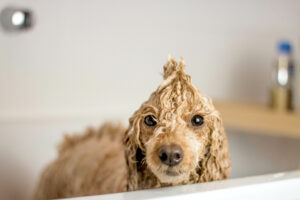
Part of taking care of your pet is regular grooming efforts to keep their coat healthy and your pet comfortable. These tips will help you stay on top of their grooming and keep your pet happy and healthy.
First, be sure to regularly brush your pet’s coat to prevent matting. Especially with long-haired animals. Your pet needs regular brushing regardless of the breed to keep its coat shiny and healthy. The amount of brushing depends on coat length and texture. Longhaired breeds will need more frequent brushing of at least once a week if not every other day. Short-haired breeds like greyhounds or Labradors may need a good brushing only every other week. Matting can cause pain for your pet. This will lead to licking or biting, causing skin irritation which can then lead to skin infections. Be sure to brush your pet regularly to keep their coat healthy.
Second, many pet owners choose to have a groomer take care of their pet’s hair care. That said, if you proceed carefully, you can trim overgrown hair around your pet’s eyes or pays in between professional grooming appointments. Trimming the hair around your pet’s eyes can prevent overgrown hair from blocking its vision and rubbing against and damaging its eyes. When trimming, make sure your pet is calm and lying down, preferably. Move slowly and calmly and use extra caution with scissors. Make sure to reward their calmness with a treat after they are finished.
Third, trimming your pet’s nails will keep them from experiencing discomfort from overly long nails. There are many different tools to do so, and you may have some trial and error until you find what works best. There are plenty of resources found online for guidance on your specific pet and how to trim its nails.
When grooming your pet, be sure to check their ears for ear infections. Ear infections can be painful, so if you notice any inflammation, odd smells, shaking or scratching, discharge, or pain upon touch. If you notice any of these signs during your regular grooming, take your pet to the vet for a checkup.
Grooming your pet is part of their regular care of them such as feeding them and providing them with exercise. With these tips, you can be more prepared for helping your pet take care of itself. Of course, with any questions, feel free to contact Dr. Olsen at Olsen Veterinary Clinic at 618-656-5868.
Dr. Olsen’s Breed Spotlight: The Peterbald Cat

The Peterbald cat is a loyal and affectionate feline, known for being “dog-like”. They are very friendly, playful, energetic, and smart. The Peterbald is a descendent of the Don Sphynx cat, still bearing some of its qualities like its varying amount of fur, dexterous front paws, big ears, and wrinkly skin. The other feline in a Peterbald cat is the Oriental Shorthair cat. The Peterbald still carries its long and lithe body shape and oblong head shape from them. However, unique to a Peterbald is their long front toes with webbing. It allows them to hold and manipulate toys, unlike many other cats.
The Peterbald’s fur varies from a velvety, fuzzy fur to a completely hairless cat. There is even a type that doesn’t even have whiskers or eyebrows, making their skin feel sticky to the touch. Also interesting is that Peterbald’s fur changes throughout their life. This means that if a Peterbald has one of these coats at birth, it can change significantly during their first two years of life, and the hair can be altered, gained, or lost.
The care of Peterbald cats varies based on their coat. If they have a thin fur coat or no hair at all, they require weekly bathing and wipe downs to keep their skin free of harmful oils. Since Peterbald cats can have very thin coats, they need to be kept as inside cats. Moreover, many Peterbald cats can sunburn, have sensitivity to extreme temperatures, and can be easily injured when playing with other cats or children. But given proper care, these cats are relatively low maintenance and have very few associated breed-health issues.
If you are looking to adopt a Peterbald, know that these cats are still somewhat rare, so acquiring one is not an easy feat. Be sure to check with animal shelters, rescue groups, and reputable breeders to see if a Peterbald is needing a forever home. Since they are often not readily available, it can be difficult to find a Peterbald kitten. Important to note is that hairless cats are often sold for higher prices.
If you have any questions, feel free to contact Dr. Olsen at Olsen Veterinary Clinic at 618-656-5868!
Seatbelts For Dogs – What You Need To Know
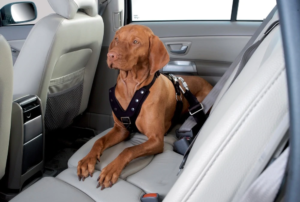 When you get into the car, you think about bucking yourself up. Your dog is most likely not getting their own seatbelt. In fact, 84 percent of pet owners don’t restrain their dogs on car trips according to a survey done by AAA. Even if you think you have the calmest dog in the world, your dog does need a seat belt. It helps keep them and the driver safe.
When you get into the car, you think about bucking yourself up. Your dog is most likely not getting their own seatbelt. In fact, 84 percent of pet owners don’t restrain their dogs on car trips according to a survey done by AAA. Even if you think you have the calmest dog in the world, your dog does need a seat belt. It helps keep them and the driver safe.
When dogs are restrained or contained in the car, they can’t distract the driver as much. According to the CDC, nine people are killed and 1,000 more injured because they were distracted while driving every day. While cell phones are the biggest distracter, your pet can be a major attention grabber too. Roughly two out of three dog owners admit to being distracted by their pup in the car. If you are in an accident, a dog without a seatbelt can turn into a deadly projectile. A ten-pound dog exerts 500 pounds of force during a 50-mph collision while a 60-pound dog becomes a 2,700-pound projectile at 35-mph. Overall, a dog without a seatbelt can cause serious damage in an accident.
Some states require pet restraint laws. So far, only three have laws that require your dog to buckle up in the car, Rhode Island, Hawaii, and New Jersey. Others forbid pets from riding in the back of pick-up trucks or on a driver’s lap. While Illinois does not have any specific pet restraint laws, you can still get a ticket for distracted driving if you get pulled over and your dog is not restrained. The safest place for dogs is in a carrier or harness in the back seat. Just as an airbag can damage a child, the same is for your pet. To get your pet used to a harness, start slowly with five-minute trips, and then expand to ten- and 15-minute rides. Eventually your dog will get used to it. During the outing, be sure to give your dog plenty of praise and a treat after the run.
When you get into the car, you think about bucking yourself up. Your dog is most likely not getting their own seatbelt. In fact, 84 percent of pet owners don’t restrain their dogs on car trips according to a survey done by AAA. Even if you think you have the calmest dog in the world, your dog does need a seat belt. It helps keep them and the driver safe. When dogs are restrained or contained in the car, they can’t distract the driver as much. According to the CDC, nine people are killed and 1,000 more injured because they were distracted while driving every day. While cell phones are the biggest distracter, your pet can be a major attention grabber too. Roughly two out of three dog owners admit to being distracted by their pup in the car.
If you are in an accident, a dog without a seatbelt can turn into a deadly projectile. A ten-pound dog exerts 500 pounds of force during a 50-mph collision while a 60-pound dog becomes a 2,700-pound projectile at 35-mph. Overall, a dog without a seatbelt can cause serious damage in an accident.
Some states require pet restraint laws. So far, only three have laws that require your dog to buckle up in the car, Rhode Island, Hawaii, and New Jersey. Others forbid pets from riding in the back of pick-up trucks or on a driver’s lap. While Illinois does not have any specific pet restraint laws, you can still get a ticket for distracted driving if you get pulled over and your dog is not restrained.
The safest place for dogs is in a carrier or harness in the back seat. Just as an airbag can damage a child, the same is for your pet. To get your pet used to a harness, start slowly with five-minute trips, and then expand to ten- and 15-minute rides. Eventually your dog will get used to it. During the outing, be sure to give your dog plenty of praise and a treat after the run.
It may be tempting to have your dog ride shotgun with you, but for their safety and yours, keep them buckled up in the back. With any questions, feel free to contact Dr. Olsen at Olsen Veterinary Clinic at 618-656-5868!
Holiday Pet Gift Guide – 2021
 The holidays are a time for giving, and you can’t forget about your pets or a pet-lover in your life. I’ve assembled a list of the best pet gifts around to show your furry loved ones you care and help them participate in the holiday spirit.
The holidays are a time for giving, and you can’t forget about your pets or a pet-lover in your life. I’ve assembled a list of the best pet gifts around to show your furry loved ones you care and help them participate in the holiday spirit.
The easiest gift is that of more toys for your pet. You can get new toys you think they would like or replace the favorites that always seem to go missing. Here are some cute toy options that your pet would love. Here is a cute Christmas pickle dog toy. Here is a winter rope dog toy. Here is a cute snowman cat toy. Here is a catnip-based reindeer cat toy.
More practical, you could get new essentials like water or food bowls or new leashes. Items like these are always welcome since they get used daily by pets. Here is a nice modern option that is useful and still looks nice in your home. Here is the link.
For a more unique gift, you could get a pet DNA kit to see what their history is as an animal. For some kits, you can learn about their preferences as an individual animal. An example cat DNA test is linked here. Here is a dog DNA test. Here is a pet food and environmental intolerance test to see what bothers your pet.
You could also get your pet a nice jacket to keep them extra warm in the cold winter months. An example one for your dog is linked here. Maybe you’d like a more fun outfit to wear on the special holiday. An example is linked here.
Perhaps your dog likes to stick their head out the window. Some protective goggles for their eyes can be found linked here.
For the pet-lover in your life, you could get them a personalized pin for them to display their furry friend with pride. A handmade pin can be found linked here.
Maybe you are looking to splurge on your pet this winter. If your pet wants to go outside and is not allowed, or maybe they are getting old and can’t move as much as they used to but still wants to enjoy the outdoors, they could use a stroller like this one linked here to enjoy nature. Another splurge item could be this activity monitoring pet tracker. It’ll allow you to stay on top of your pet’s health.
Sharing the season of giving with your pets will only make it more enjoyable. If you have any questions, feel free to contact Dr. Olsen at 618-656-5868 or send him an email here!
Introducing Your Cat To A Newly Adopted Cat: 6 Tips for Success
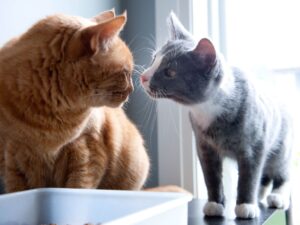 Adopting a cat can do a lot of good. You are giving a cat a loving home who may not have had one before. However, if you already have one or more cats at home, introducing a new feline can be tricky. Especially so if the cats have different personality or between a cat that loves being an only-child and a new kitten. To avoid any extra stress, here are six tips to help your cats acclimate.
Adopting a cat can do a lot of good. You are giving a cat a loving home who may not have had one before. However, if you already have one or more cats at home, introducing a new feline can be tricky. Especially so if the cats have different personality or between a cat that loves being an only-child and a new kitten. To avoid any extra stress, here are six tips to help your cats acclimate.
Create a Separate Kitten Space
When bringing a new cat home, the first thing should always be to provide your feline with a safe place. This space gives your cat a sense of familiarity and a place to retreat to if the new house ever gets overwhelmed. This area should be secure from the rest of the house and other felines. In this space, you should have a litter box, food bowl, water bowl, and plenty of toys to keep your kitten occupied when you aren’t home. You should also have safe hiding and sleeping areas for maximum comfort.
Handle Vet Visits Right Away
Part of the adoption process is a regular vet check-up. Schedule your kitten’s first visits to the vet on the same day you plan to bring your cat home. This should include a wellness exam, vaccinations needed, and a discussion about spaying or neutering if your kitten is not already fixed.
In addition, take some time to trim your kitten’s claws and groom its fur before leaving the cat in their designated space. Not only do these tasks help you bond with your new cat, but they also can reduce the risk of stress responses to the presence of the resident cat.
Introduce the Cats Slowly
Cats are very territorial. A new kitten can feel like a threat to your resident cat, so it is important to make new introductions slowly. Anticipate keeping the kitten separate for at least a few days. After the first day or two, give each of your cats an item with the other animal’s scent on it. A blanket, cushion, or fabric toy for example. Place this item in an area where your cat feels comfortable. Avoid specifically approaching either cat with a scented item, as it could be understood as a threat.
Once your cats get used to each other’s scents, you can allow them to interact in limited ways. For example, let them interact through a baby gate or sniff under the door of the other cat’s designated area. Only after your cats begin to behave normally when in proximity to each other should you allow them to meet.
Keep Watch for Any Warning Signs
Change can be extremely upsetting for your cats. Your resident cat may feel like its space is being violated and your new kitten may struggle to get used to a new home and a new sibling at the same time. If either cat gets aggressive, start the introduction process over by separating the cats. This helps your animals and their autonomy and safety feel less threatened.
Stay Patient Through the Introductions
Many cats can learn to live together, but it’s up to you to give them time to get used to the idea. The introduction process should take no less than a week’s time. Before bringing a new cat home, ensure that you have the time and resources to handle this process with care and compassion. You will need to spend dedicated time with both cats to ease the transition and bond.
Understand How to Respond to Aggression
When cats begin to live with each other, they may play fight or compete for attention or toys. For the first few days after your cats are allowed to interact freely, pay attention to their behavior. Normal play may involve a fair amount of batting, pouncing, and so on. If you see threat displays like hissing and arching, distract the cats with a loud noise or toy so that they can retreat. If possible, avoid letting serious physical altercations occur. If necessary, separate the cats until they both calm down. A fight could mean injuries for you and your cats.
Introducing a new cat can be tricky, but with some patience, you can build a happy family with your new felines. Feel free to contact us here or call Olsen Veterinary Clinic at 618-656-5868 with any questions.
What to Do Before Adopting a New Pet
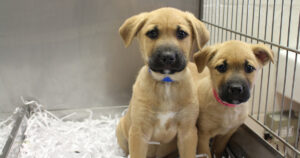 Adopting a pet is an exciting time for you and your family. However, it can be very overwhelming before your new furry friend comes home. Today, we will be discussing what you should do before your new pet comes to their forever home.
Adopting a pet is an exciting time for you and your family. However, it can be very overwhelming before your new furry friend comes home. Today, we will be discussing what you should do before your new pet comes to their forever home.
First, you should consider your current family. Do you have any other pets? How will they react to bringing in a new pet into the home? You also need to consider how your current home will serve for your new pet. Will your social life or work obligations affect your ability to care for this new pet? How do the other people you live with feel about having a new pet in the house? Are there any health issues that need to be accommodated? What kind of lifestyle do you want to live with your new pet? Are you looking for a dog to go running with or a cat to chill with? Are you in the position to train a pet with behavior issues or are you looking for a more relaxed pet experience? All these questions serve as a guide as to what kind, if any, pet you should adopt. If your current life is not suitable for a pet, maybe it’d be best to wait some time to where you will be more prepared to give your new pet the life they deserve.
More likely than not, the adopting agency will charge a fee to help mediate the costs of taking in unwanted or lost animals. This adoption fee will be a tiny fraction of money compared to how much money you will be spending over the life of your pet. You may also need to pay for your pet to be spayed or neutered before bringing them home. Some mandatory expenses of caring for a pet include food, veterinary care, licensing, collars/leashes/ID tags, cat litter, and grooming supplies. Other expenses that are highly recommended but not mandatory are permanent identification in the form of microchipping, training classes, professional grooming, spare supplies, beds, toys, crates, or carriers. There is also the chance that your furry friend will need emergency veterinary care which can get quite pricy. Before adopting a pet, it is important to make sure that you have the right financial state to be able to care and provide for your pet.
Before bringing your new pet home, you need to make sure that you will have the time to spend on taking care of your pet. Pets need to be fed two to three times a day. A pet parent should spend at least one hour per day giving direct attention to your pet in the form of training, exercising, grooming, or playing with them. A pet with a lot of energy will need more time to exercise and play with toys. Pets with long coats will need twenty minutes per day of grooming to keep their coat silky and not matted. Pets with medical conditions will also need extra attention. In the beginning of your adopted pet being home, they may need additional bonding and reassurance time in the first few weeks.
If you are completely prepared to give your pet the best life possible, the last thing you will need to supply are the necessary items for pet care. For dogs, these are food and water bowls, food, collars, leashes, ID tags, a bed, shampoo, nail clippers, brush/comb, poop baggies, toys, treats, and first aid supplies. For cats, they will need food and water bowls, food, kitty litter, collars, ID tag, carrier, nail clippers, brush/comb, toys, and first aid supplies. It could be best, however, to wait to see the size of your new pet for some of these items, as they will vary based on how big or small your new friend is.
Adopting a pet is an enjoyable yet stressful time in one’s life. Hopefully this list of preparation has made you feel more relaxed and prepared to bring your furry friend home. As always, feel free to contact Dr. Olsen at Olsen Veterinary Clinic at 618-656-5868 with any questions.
Dr. Olsen’s Breed Spotlight: The Irish Wolfhound
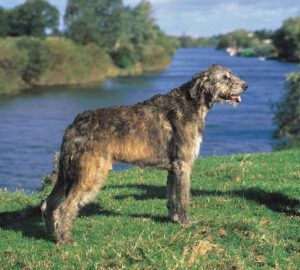 For this next breed spotlight, I will be introducing you to the Irish wolfhound, likely for the first time. This dog is calm, dignified, and the tallest breed of dog (sorry Great Danes). Early ancestors of Irish wolfhounds were fearless, big-game hunters who could dispatch a wolf in single combat. Today, they are the most serene and agreeable of companions.
For this next breed spotlight, I will be introducing you to the Irish wolfhound, likely for the first time. This dog is calm, dignified, and the tallest breed of dog (sorry Great Danes). Early ancestors of Irish wolfhounds were fearless, big-game hunters who could dispatch a wolf in single combat. Today, they are the most serene and agreeable of companions.
The amiable Irish Wolfhound is an immense and muscular hound. They are built along classic Greyhound lines, capable of great speeds at a gallop. A male might stand nearly three feet at the shoulder and can weigh up to 180 pounds. Females will run smaller but are still a very large dog. They have a rough and hard coat that can come in many colors. They can be white, gray, brindle, red, black, and fawn. Irish wolfhounds are way too serene to be fierce guard dogs, but the mere sight of the size of these dogs are enough to deter intruders. Irish wolfhounds are characteristically patient with kids, but their size does require supervision when they are around small children.
The history of this wolfhound goes back to the breeding of indigenous large dogs of Britain to the Middle Eastern coursing hounds that were bartered around the known world in the earliest days of international trade. By the time the Roman Empire had gained a toehold in the British Isles, the giant hounds of Ireland were already long established. In the year 391, the Roman consul received a gift of seven of these hounds that “all Rome viewed with wonder”. These majestic hunters, whose motto was “gentle when stroked, fierce when provoked”, were used on such quarry as the now-extinct Irish elk, a massive, ferocious beast said to stand six feet at the shoulder. In 15th-century Ireland, wolves were overrunning the countryside. The Irish hounds, already renowned big-game hunters, began to specialize on wolves. By the late 1700s, when wolves and other big-game animals of Ireland were hunted to extinctions, Irish wolfhounds lost their job and nearly went extinct themselves. This is a case of a breed doing its job too well for its own good. In 1862, British army captain George Augustus Graham began scouring the country for remaining specimens of Ireland’s national hound. Graham made it his life’s work to protect, standardize, and promote the breed. Today, his name is still spoken with reverence wherever Irish wolfhound fanciers gather.
The coats of Irish wolfhounds have two layers; the outer being harsh and wiry with the under being very soft. They shed throughout the year, but not in an excessive amount. Unlike many other double-coated breeds, Irish wolfhounds don’t “blow out” their coats during an annual or semi-annual shedding season. Irish wolfhounds retain a strong instinct to hunt and chase prey, so they should only be allowed off the leash in areas that are securely fenced. As adults, Irish wolfhounds can become couch potatoes if allowed to, but regular exercise like long walks and play sessions help keep them physically and mentally healthy. A home with a large, fenced area is necessary to provide the environment needed for this breed to thrive. The breed can also exercise mind and body by participating in canine sports like tracking, agility, and lure coursing.
These gentle giants are sure are a breed with a rich history. Their ancestors’ traits reveal themselves with their passion for hunting and need for mental and physical exercise. Generally, these dogs make excellent companions for anyone with enough land to satisfy their need to run. With any questions, please feel free to contact Dr. Olsen at 618-656-5868.
Can Dogs and Cats Cohabitate?
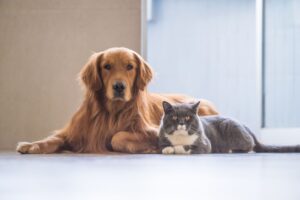 Many pet parents do not have just one pet. They have multiple cats, multiple dogs, etc. A big question for many pet parents is whether a dog and cat can live together peacefully. Canines and felines are not known to be great friends, but they are able to learn to tolerate each other and even develop a strong, loving bond. Acquiring this requires some careful preparation, but it is possible to develop a union between your cats and dogs.
Many pet parents do not have just one pet. They have multiple cats, multiple dogs, etc. A big question for many pet parents is whether a dog and cat can live together peacefully. Canines and felines are not known to be great friends, but they are able to learn to tolerate each other and even develop a strong, loving bond. Acquiring this requires some careful preparation, but it is possible to develop a union between your cats and dogs.
Dogs and cats are not destined to be foes. A nurturing friendship between your dog and cat is possible, regardless of what myths society has adopted. If dogs and cats are property socialized, they are able to become friends. It may just take some time for your dog and cat who have never met to acclimate to each other. It is important to note that both animals are territorial and have different communication methods that can impact their behavior. For example, a dog wags its tail to show happiness and eagerness to play. On the other hand, cats lash their tail to indicate anger and displeasure. It is easiest for animals to cohabitate if they are both raised together from a young age. Similarly, when distributing treats, attention, or praise, be sure to distribute them equally in order to prevent jealousy.
It is not always easy to introduce your cat or dog to your resident pet, it can take several weeks or even months. Be patient but realize that whether or not your pet gets along will depend as much on their personalities as on how you approach the process. Follow these initial steps to help accommodate your pets as much as possible.
First, choose a proper location for the first meeting of your pets. If your pet is a long-term resident of a specific room, they may act territorial and take offence when the new animal is on its turf. Start with a neutral ground to the both of them. Second, keep the animals separated initially. Across several days, rotate which animal has freedom and which is confined to allow each pet plenty of time to investigate the other animal’s scent. Next, make face-to-face introductions. Allow both pets to be in the same room at the same time, but keep the dog leashed. Continue with this type of interaction until your cat stays calm and ignores the dog, and vice versa. Lastly, proceed with caution. Once the pets consistently get along during leashed visits, they are ready for the next step of removing the leash. Do not leave them alone with each other until you are sure that they are fully comfortable with each other.
Properly introducing your cats and dogs to live together can be extremely influential in a peaceful cohabitation between your dog and cat. Be sure to remain watchful and alert while the meeting process is occurring. With a little patience, your pets will successfully be cohabitating happily in no time.
As always, we are here to help with anything you need for your furry family member. Contact us today with your questions!
